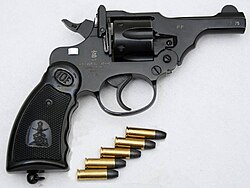The use of the term "cannon" is interchangeable with "gun" as words borrowed from the French language during the early 15th century, from Old French canon, itself a borrowing from the Italian cannone, a "large tube" augmentative of Latin canna "reed or cane". Recent scholarship indicates that the term "gun" may also have its origins in the Norse woman's name "Gunnildr", which was often shortened to "Gunna". The earliest recorded use of the term "gonne" was in a Latin document circa 1339. Other names for guns during this era were "schioppi" (Italian translation-"thunderers"), and "donrebusse" (Dutch translation-"thunder gun") which was incorporated into the English language as "blunderbuss". Artillerymen were often referred to as "gonners" and "artillers". Early guns and the men who used them were often associated with the devil and the gunner's craft was considered a black art, a point reinforced by the smell of sulfur on battlefields created from the firing of guns along with the muzzle blast and accompanying flash.

In military use, the term "gun" refers primarily to direct fire weapons that capitalize on their velocity for penetration or range. In modern parlance, these weapons are breech-loaded and built primarily for long range fire with a low or almost flat ballistic arc. A variation is the howitzer or gun-howitzer designed to offer the ability to fire both low or high-angle ballistic arcs. In this use, example guns include naval guns. A less strict application of the word is to identify one artillery weapon system or non-machine gun projectile armament on aircraft.

The word cannon is retained in some cases for the actual gun tube but not the weapon system. The title gunner is applied to the member of the team charged with operating, aiming, and firing a gun.
Autocannon are automatic guns designed primarily to fire shells and are mounted on a vehicle or other mount. Machine guns are similar, but usually designed to fire simple projectiles. In some calibers and some usages, these two definitions overlap.

A related military use of the word is in describing gun-type fission weapon. In this instance, the "gun" is part of a nuclear weapon and contains an explosively propelled sub-critical slug of fissile material within a barrel to be fired into a second sub-critical mass in order to initiate the fission reaction. Potentially confused with this usage are small nuclear devices capable of being fired by artillery or recoilless rifle.
In civilian use, a related item used in agriculture is a captive bolt gun. Such captive piston guns are often used to humanely stun farm animals for slaughter.

Shotguns are normally civilian weapons used primarily for hunting. These weapons are typically smooth bored and fire a shell containing small lead or steel balls. Variations use rifled barrels or fire other projectiles including solid lead slugs, a Taser XREP projectile capable of stunning a target, or other payloads. In military versions, these weapons are often used to burst door hinges or locks in addition to antipersonnel uses.
Generally, guns use compressed gas confined by the barrel to propel the bullet up to high speed, though devices operating in other ways are sometimes called guns. In guns that are firearms the high pressure gas is generated by combustion, usually of gun powder. This principle is similar to that of internal combustion engines, except that the bullet leaves the barrel, but the piston transfers its motion to other parts and returns down the cylinder. As in an internal combustion engine, the combustion propagates by deflagration rather than by detonation, and good gunpowder, like good motor fuel, is resistant to detonation. This is because much of the energy generated in detonation is in the form of a shock wave, which can propagate from the gas to the solid structure and heat or damage the structure, rather than staying as heat to propel the piston or bullet. The speed of a shock wave at such high temperature and pressure is much faster than that of any bullet. October's birthstone treats the eye to an explosion of shimmering colors, not unlike those of a magnificent rainbow following a summer rain. The Opal derives its name from the Latin word "opalus," meaning precious jewel. Prized for its unique ability to refract and reflect specific wavelengths of light, the Opal was called "Cupid Paederos" by the Romans, meaning a child beautiful as love. One legendary explanation for this gemstone's origin is that it fell from heaven in a flash of fiery lightning.
October's birthstone treats the eye to an explosion of shimmering colors, not unlike those of a magnificent rainbow following a summer rain. The Opal derives its name from the Latin word "opalus," meaning precious jewel. Prized for its unique ability to refract and reflect specific wavelengths of light, the Opal was called "Cupid Paederos" by the Romans, meaning a child beautiful as love. One legendary explanation for this gemstone's origin is that it fell from heaven in a flash of fiery lightning.